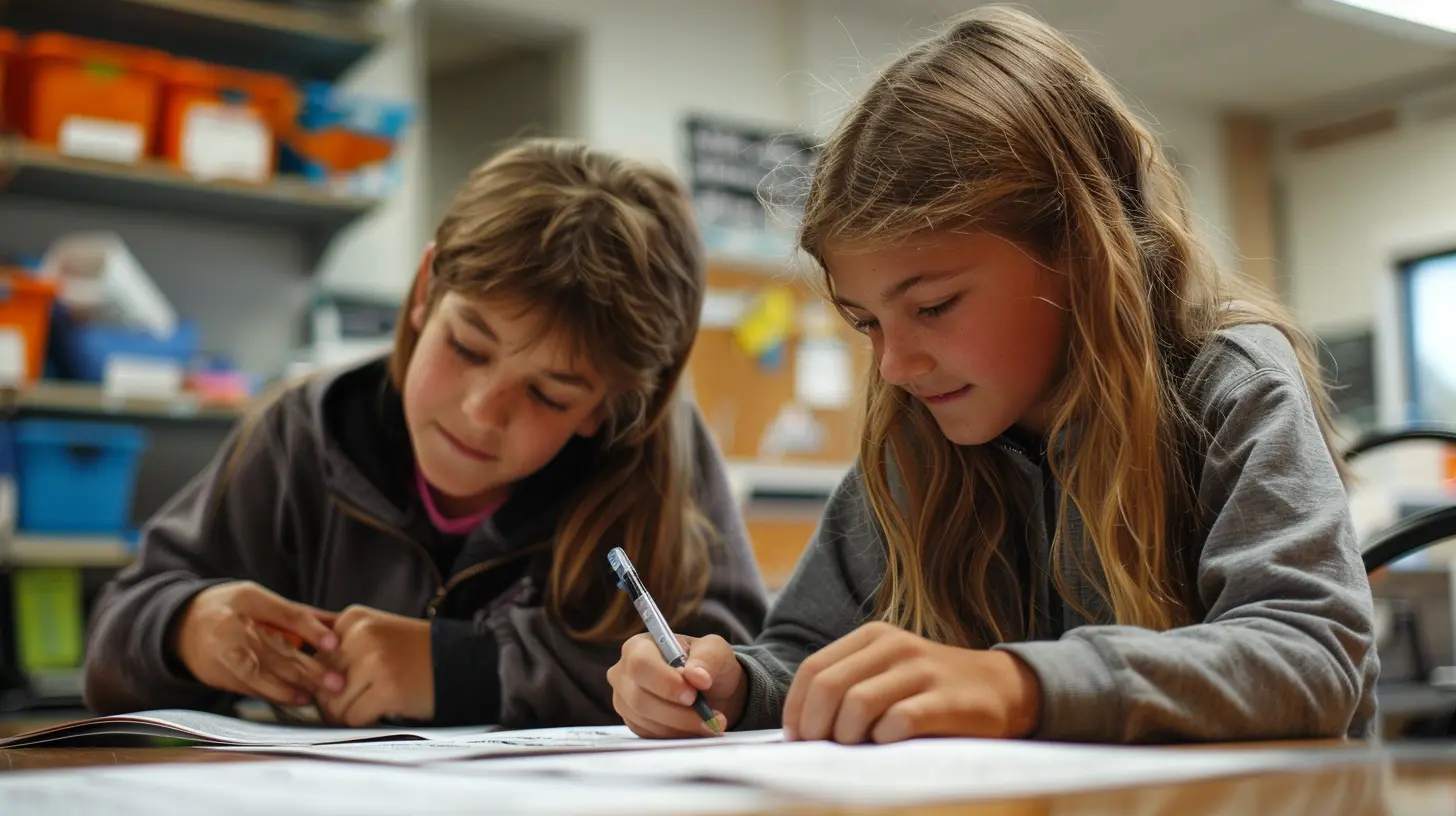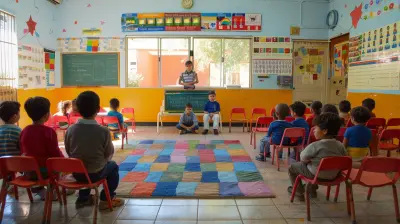The Benefits of Co-Constructing Rubrics with Students
24 April 2025
In today's classrooms, assessment isn't just about grading—it's about growth. One of the most effective ways to ensure students truly understand expectations and take ownership of their learning is through co-constructing rubrics. Instead of handing out a pre-made grading rubric, why not let students help create it?
This approach not only improves transparency in assessment but also fosters engagement, critical thinking, and collaboration. So, let's dive into why co-constructing rubrics with students is a game-changer in education. 
What Is a Co-Constructed Rubric?
A co-constructed rubric is a grading guide developed collaboratively by teachers and students. Instead of a top-down approach where educators dictate the grading criteria, students actively participate in defining what success looks like.This method encourages student voice and agency—two essential elements of meaningful learning. When students help define expectations, they internalize them better, leading to improved performance and deeper understanding. 
Why Should Students Be Involved in Creating Rubrics?
Handing students a pre-made rubric is like giving them a recipe without explaining why certain ingredients matter. They might follow it, but they won’t truly grasp the reasoning behind it.By involving students in rubric creation, educators can:
- Increase student motivation – When students help define success, they’re more invested in achieving it.
- Enhance clarity – Many students don’t fully understand grading criteria. Building rubrics together ensures they do.
- Boost critical thinking – Students must analyze what makes a piece of work good or bad, sharpening their evaluative skills.
- Promote a growth mindset – Instead of seeing grading as punishment, students view assessment as a tool for improvement. 
The Key Benefits of Co-Constructing Rubrics
1. Encourages Student Ownership Over Learning
When students help shape their learning experience, they take ownership of it. They no longer see assessments as something happening to them but rather something they have a say in.Think about it—if you had a hand in creating the rules of a game, wouldn’t you be more engaged in playing it? The same logic applies to grading. Students who co-create rubrics feel a greater sense of responsibility toward their work, leading to higher effort and improved outcomes.
2. Improves Clarity and Consistency in Assessment
Let’s be honest—grading can sometimes feel like a mystery to students. Traditional rubrics, full of academic jargon, can be confusing and vague.When students help build a rubric, they put it in their own language, making expectations crystal clear. This means fewer “Why did I get this grade?” questions and more confidence in self-assessment.
Additionally, co-constructed rubrics reduce subjectivity in grading. Since students help define the criteria, they understand exactly what’s expected and feel their work is assessed fairly and consistently.
3. Develops Critical Thinking and Analytical Skills
Creating a rubric isn’t just about deciding what’s “good” or “bad.” It requires students to analyze, compare, and think critically about what makes a piece of work high-quality.For instance, if students are developing a rubric for an essay, they must discuss:
- What makes a strong thesis statement?
- How should evidence be integrated?
- What level of coherence and organization is expected?
This process helps them think like evaluators, building skills that go beyond the classroom and into the real world.
4. Encourages Collaborative Learning
Co-constructing rubrics isn’t a solo task—it’s a collaborative effort. Students must engage in discussions, negotiate meaning, and come to a consensus.This builds:
- Communication skills – Students articulate their ideas and justify their reasoning.
- Respect for diverse perspectives – They see how different people value different aspects of work.
- A sense of community – Learning becomes a shared experience rather than an individual struggle.
It’s teamwork in action, preparing students for real-world situations where collaboration is essential.
5. Reduces Anxiety Around Assessments
Grades can be stressful, especially when expectations feel ambiguous. But when students help create their own assessment tools, they feel in control of the process.Instead of fearing feedback, they see rubrics as a roadmap to success. They know exactly what’s expected, which reduces confusion and builds confidence.
Think of it like studying for a test—having a detailed study guide makes it far less intimidating. A co-constructed rubric works in the same way by providing clear benchmarks for success.
6. Fosters a Growth Mindset
In traditional grading systems, students often focus on the grade rather than the learning process. They see marks as fixed judgments rather than tools for growth.Co-constructed rubrics shift this mindset. Since students play a role in setting expectations, they begin to view grading as a reflection of progress rather than a final verdict.
This encourages:
- Self-reflection – Students assess their own work based on shared criteria.
- Resilience – They understand that improvement is possible, even if they don’t get things right the first time.
- Intrinsic motivation – They strive to meet expectations because they helped define them, not just to chase a grade. 
How to Co-Construct a Rubric with Students
Thinking about trying this in your classroom? Here’s a simple step-by-step guide to get started:1. Define the Task Clearly
Before creating the rubric, ensure students fully understand the assignment or skill being assessed. What are they expected to produce? What are the learning goals?2. Brainstorm Criteria Together
Ask students:- What makes a strong piece of work?
- What common mistakes should we avoid?
- What does “excellent” vs. “average” look like?
Encourage open discussion and record their ideas.
3. Categorize and Refine Criteria
Group similar ideas together and refine them into clear, measurable criteria. Avoid vague terms like “good” or “nice” in favor of specific descriptions.4. Define Levels of Performance
Determine different levels of achievement (e.g., Exceeds Expectations, Meets Expectations, Needs Improvement). Ensure descriptions for each level are clear and meaningful.5. Test and Revise the Rubric
Before using the rubric for grading, test it on a sample piece of work. Does it make sense? Are there gaps? Fine-tune based on student feedback.6. Use the Rubric for Self and Peer Assessment
Encourage students to evaluate their own work (and each other’s) using the rubric before submitting final drafts. This reinforces their understanding and promotes self-improvement.Final Thoughts
Co-constructing rubrics with students isn’t just about making grading fairer—it’s about transforming assessment into a meaningful learning experience.When students take part in defining success, they engage more deeply, think critically, and develop essential life skills. It shifts the focus from “What grade did I get?” to “How can I improve?”—which is the ultimate goal of education.
So, if you haven’t tried this approach yet, what’s stopping you? Hand over some of the control, involve your students in the process, and watch as they take ownership of their learning like never before.
all images in this post were generated using AI tools
Category:
Rubrics And GradingAuthor:

Monica O`Neal
Discussion
rate this article
6 comments
Violet Jimenez
Co-constructing rubrics with students fosters collaboration, enhances understanding of assessment criteria, and empowers learners. This approach not only improves engagement but also promotes accountability and ownership in the learning process.
May 15, 2025 at 10:37 AM

Monica O`Neal
Thank you for highlighting these key benefits! Co-constructing rubrics indeed transforms assessments into collaborative experiences that enhance student engagement and ownership of learning.
Zachary McQuade
This article highlights the value of co-constructing rubrics with students, fostering engagement and ownership in learning. It encourages collaboration, enhances understanding of assessment criteria, and promotes transparency in evaluation.
May 13, 2025 at 12:47 PM

Monica O`Neal
Thank you for your insightful comment! I appreciate your recognition of how co-constructing rubrics fosters engagement and empowers students in their learning journey.
Zaren Cook
Co-constructing rubrics with students fosters engagement and ownership in the learning process. It helps clarify expectations, enhances feedback quality, and promotes a deeper understanding of assessment criteria, ultimately leading to improved student performance and motivation. A powerful teaching strategy!
May 11, 2025 at 12:36 PM

Monica O`Neal
Thank you for your insightful comment! I completely agree that co-constructing rubrics not only clarifies expectations but also empowers students, fostering both engagement and improved performance. Your emphasis on ownership in the learning process is spot on!
Vincent Montgomery
Oh sure, let’s just hand over the rubrics to students! Who needs structure and clarity when we can revel in the joy of chaos and let them decide what “excellent” really means? Sounds fun!
May 9, 2025 at 2:50 AM

Monica O`Neal
I appreciate your concern! Co-constructing rubrics actually enhances structure and clarity by fostering collaboration and shared understanding, empowering students to take ownership of their learning.
Esther Fisher
Co-constructing rubrics empowers students by giving them ownership of their learning. It fosters collaboration and critical thinking, creating a meaningful educational experience. Together, we can build a brighter future!
May 5, 2025 at 12:52 PM

Monica O`Neal
Thank you for your insightful comment! I completely agree that co-constructing rubrics not only enhances student ownership but also promotes collaboration and critical thinking for a richer learning experience.
Rina Wyatt
Empower students, elevate assessments!
April 25, 2025 at 7:05 PM

Monica O`Neal
Absolutely! Co-constructing rubrics with students not only empowers them but also enhances the quality and relevance of assessments.




